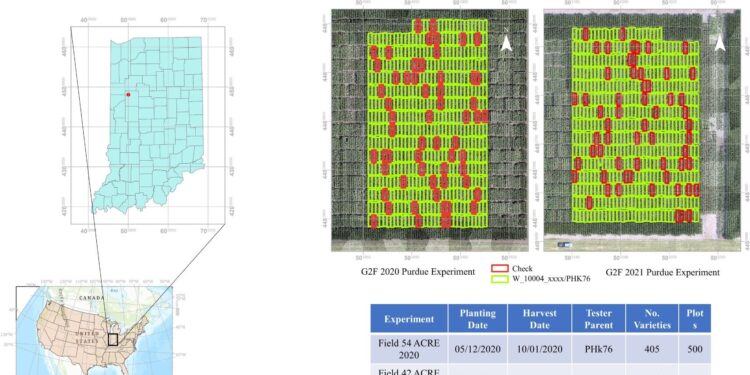(A) Geographic location of corn experiments at the Purdue University Center for Agricultural Research and Education. (B) Experimental plot layouts for GxE plant breeding experiments in 2020 and 2021. Check plots indicated in red. Credit: Frontiers of plant science (2024). DOI: 10.3389/fpls.2024.1408047
Artificial intelligence (AI) is the buzzword of 2024. While far from the cultural forefront, scientists from the agricultural, biological, and technology fields are also turning to AI as they collaborate to find ways for these algorithms and models to analyze data sets to better understand and predict a world impacted by climate change.
In a recent article published in Frontiers of plant scienceClaudia Aviles Toledo, a doctoral candidate in geomatics at Purdue University, working with her faculty advisors and co-authors Melba Crawford and Mitch Tuinstra, demonstrated the ability of a recurrent neural network—a model that teaches computers to process data using long-term memory—to predict corn yield from multiple remote sensing technologies and environmental and genetic data.
Plant phenotyping, which involves examining and characterizing plant characteristics, can be a laborious task. Measuring plant height with a tape measure, assessing reflected light at multiple wavelengths with heavy, portable equipment, and pulling and drying individual plants for chemical analysis are all costly and labor-intensive efforts. Remote sensing, or collecting these data points remotely using unmanned aerial vehicles (UAVs) and satellites, is making this information about fields and plants more accessible.
Tuinstra, Wickersham Distinguished Chair in Agricultural Research, professor of plant breeding and genetics in the Department of Agronomy and scientific director of the Plant Sciences Institute at Purdue, said, “This study highlights how advances in drone data acquisition and processing, combined with deep learning networks, can help predict complex traits in food crops like corn.”
Crawford, the Nancy Uridil and Francis Bossu Distinguished Professor of Civil Engineering and professor of agronomy, honors Aviles Toledo and others who collected phenotypic data in the field and through remote sensing. Through this collaboration and similar studies, the world has seen how remote sensing phenotyping simultaneously reduces labor requirements and provides new information about plants that human senses alone could not discern.
Hyperspectral cameras, which make detailed measurements of the reflectance of light wavelengths outside the visible spectrum, can now be placed on robots and drones. Light detection and ranging (LiDAR) instruments emit laser pulses and measure the time they reflect back to the sensor to generate maps called “point clouds” of the geometric structure of plants.
“Plants tell their stories,” Crawford says. “They respond when they’re stressed. If they respond, you can potentially make a connection to their characteristics, environmental inputs, management practices such as fertilizer applications, irrigation or pests.”
As engineers, Aviles Toledo and Crawford build algorithms that take massive data sets and analyze the patterns within them to predict the statistical probability of different outcomes, including the yield of different hybrids developed by plant breeders like Tuinstra. These algorithms classify healthy and stressed crops before any farmer or observer can spot a difference, and they provide information about the effectiveness of different management practices.
Tuinstra brings a biological approach to the study. Plant breeders use the data to identify genes that control specific crop traits.
“This is one of the first AI models to integrate plant genetics with yield history in large-scale, multi-year experiments on plots,” Tuinstra said. “Now, plant breeders can see how different traits respond to varying conditions, which will help them select traits for more resilient future varieties. Growers can also use it to see which varieties might perform best in their region.”
Hyperspectral and LiDAR data from remote sensing of corn, genetic markers from popular corn varieties, and environmental data from weather stations were combined to build this neural network. This deep learning model is a subset of AI that learns from spatial and temporal patterns in data and makes predictions about the future. Once trained in one location or time period, the network can be updated with limited training data in another geographic location or time period, thereby limiting the need for reference data.
Crawford said: “Previously, we were using classical machine learning, which was focused on statistics and mathematics. We couldn’t really use neural networks because we didn’t have the computing power.”
Neural networks resemble grids, with links connecting points that eventually communicate with all other points. Aviles Toledo adapted this model with long-term memory, which allows past data to be constantly kept at the forefront of the computer’s “mind,” alongside present data, as it predicts future outcomes. The long-term memory model, complemented by attention mechanisms, also draws attention to physiologically important moments in the growth cycle, including flowering.
Although remote sensing and weather data are integrated into this new architecture, Crawford said genetic data is still processed to extract “aggregate statistical features.”
By collaborating with Tuinstra, Crawford’s long-term goal is to more meaningfully integrate genetic markers into the neural network and add more complex features to its dataset. This will reduce labor costs while more efficiently providing growers with the information they need to make the best decisions for their crops and land.
More information:
Claudia Aviles Toledo et al., Integration of multimodal remote sensing, deep learning and attention mechanisms for yield prediction in plant breeding experiments, Frontiers of plant science (2024). DOI: 10.3389/fpls.2024.1408047
Provided by Purdue University
Quote:AI network shows potential to predict crop yield (2024, September 24) retrieved September 24, 2024, from
This document is subject to copyright. Apart from any fair dealing for the purpose of private study or research, no part may be reproduced without written permission. The content is provided for informational purposes only.



